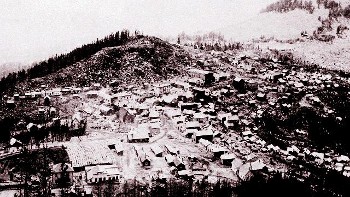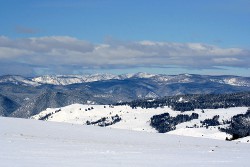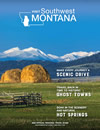Granite Begins with Silver Strike!
Originally published in the Philipsburg Mail June 3, 1980
by Danette LaTray
In the late 1800's the town of Granite, Montana, which lines six miles northeast of Philipsburg, was booming with the discovery of silver.

The city of Granite in its busy years, 1890, courtesy of the Philipsburg Mail.
The old prospectors, with wrinkled whiskered faces and mud covered overalls, strolled into the growing town. Following close behind were their dingy white mules, who were packed with rusty picks, heavy shovels, a week or two of food and bulky bedrolls that kept the miners warm on harsh, cold Montana nights. These mules carried everything the miners needed to live and tools to help them find their fortune.
There is a story told, whether fact or fiction, we do not know, that Eli Holland and James Hill are the two men credited with the discovery of silver in the Granite area as the result of an 1872 deer hunting expedition.

The story goes that Hill or Holland, or both, had killed a large buck deer on the slopes of the Granite Mountain Peak. The animal, in its struggle against death, kicked loose some rock and earth while the men were dressing the animal. They found the deer had unearthed an outcropping of silver.
Some old-timers claim the story is factual, others say the story came about as the result of a few too many in the saloon.
In Granite there were two mines - The Granite Mountain Mine and the Bi-Metallic, owned largely by St. Louis, Mo. interests. The Granite Mountain Mine and Mill produced $33 million in silver to become known as the greatest silver producer in the United States in the 1882 - 1893 era.
The city of Granite was busy 24 hours a day with the mines running three eight hour shifts, and downtown establishments also running on a 24-hour basis to keep up with working standards.
Granite is situated at 8,000 ft. in elevation, approximately a mile and a half above sea level. The air was so thin, strangers seeing the miners walking up to work might have thought them a lazy bunch of fellows or just plain reluctant to go to work. Although they soon learned that none could hurry at that elevation.

The area was known for its well below zero temperatures. It was such that a man's true size could not be judged until he was down at one of the local saloons and could shed his outer-garments in a suitable temperature. Besides the sub-zero temperatures, the wind had a clean sweep of the town from the north and east.
Granite Mountain was so-called because it was all granite. There was no dirt. The loose soil was decomposed granite... no more than coarse sand. Wells or graves could not be dug. Water was carried around in a barrel on two wheels, drawn by a horse and the water was sold in ten gallon tins.
Later a reservoir was built back in the mountains and the water was conveyed to the mine in an open ditch. The dead were brought five miles from Granite to the cemetery in Philipsburg.
The camp had approximately 7,000 men (this number did not include families, which would have brought the population to 10,000). It is only natural there would be some deaths, sometimes the preacher would be busy three times a day with such services.
In 1884 death struck quickly. To shock the whole city, Black Diphtheria ran rampant throughout the town. The "Black Death" as it was called, claimed many of the children of the families. It was said that there was no time to grieve for lost children as mothers fought desperately to save the rest of their families. Many mothers never knew which was the grave of their own child, as so many died there were few markers on individual graves, before the epidemic ended.
In 1890 the city of Granite was 11th in size among Montana cities. Such was Granite in 1894 where men were boasting that no one had found the bottom of a Montana silver mine. A few years later, due to adverse legislation, silver was not used to make money. From the old hustling, bustling camp, Granite soon was to become a town of "ghosts."
Access to searchable archives is available via the Philipsburg Mail.


